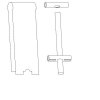Hello Gentlemen.
I'm looking for a large loom strop (at least 2.5" width) and the only one I seem to be able to find is a Maestro Livi, which sells for around $200. I do not want to spend anywhere near that, more in the neighborhood of $60-$70.
Does anyone know where I can find one?
I'm looking for a large loom strop (at least 2.5" width) and the only one I seem to be able to find is a Maestro Livi, which sells for around $200. I do not want to spend anywhere near that, more in the neighborhood of $60-$70.
Does anyone know where I can find one?


